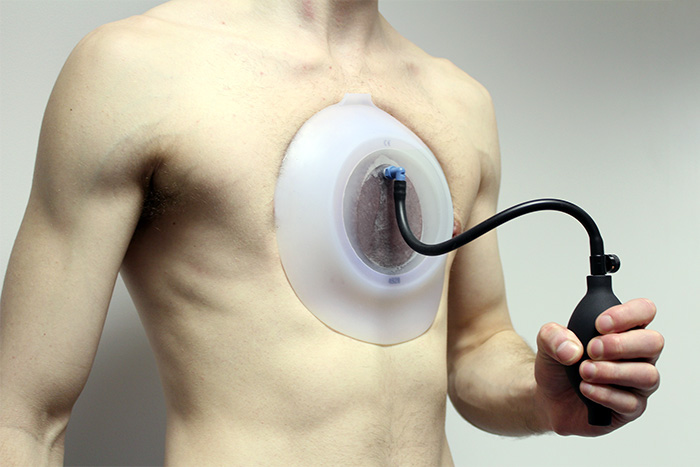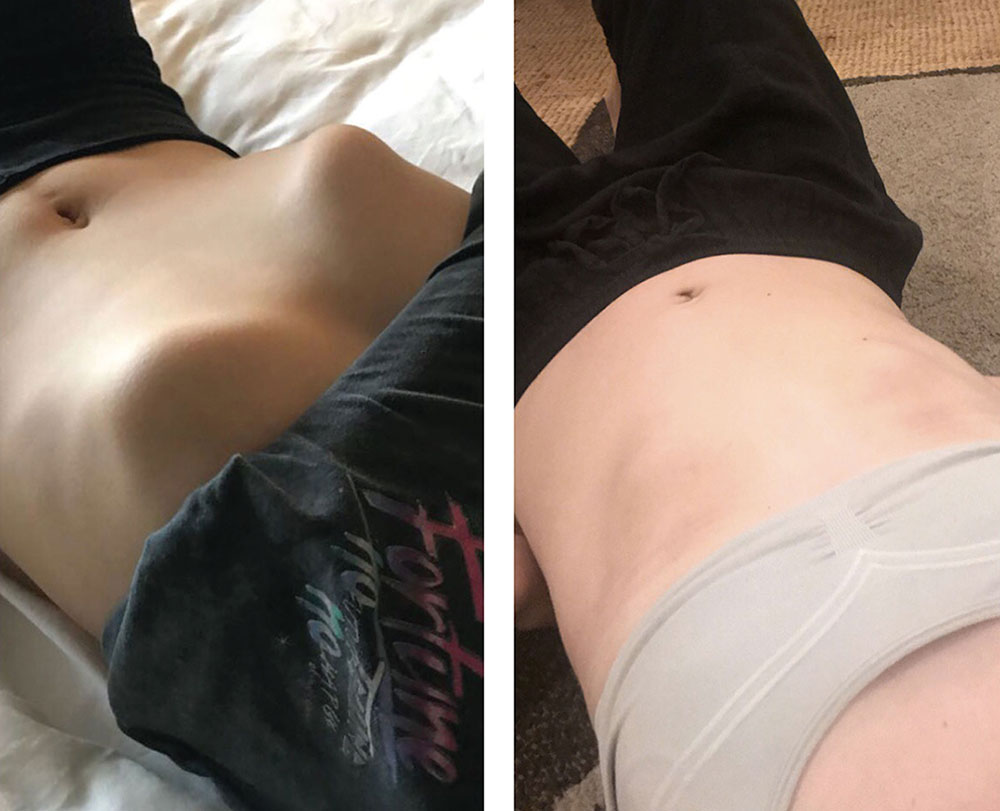The London Orthotic Consultancy’s non-surgical treatment for pectus excavatum and pectus carinatum involves wearing a bespoke brace, or orthosis, called a Dynamic Chest Compressor, in combination with a programme of yoga exercises that have been developed specifically to augment our treatment. We call our treatment programme LOCpectus.
During treatment, we monitor the progress by reviewing the patient both at our clinic and also via online video conference. We must constantly monitor and adjust the Dynamic Chest Compressor to ensure the correct correctional forces are being applied.
At each physical appointment, we will check that the brace is positioned correctly and that the correction pads are designed correctly for your changing chest shape. We realise that there is a huge commitment required from you to wear the brace and we want every moment that you wear it to be as effective as possible.
For patients considering LOC’s non-surgical treatments for pectus excavatum and pectus carinatum, we offer a free virtual consultation where our clinician will explain our treatment package and assess whether it is likely to be a suitable treatment for your particular condition.
If you jointly agree that treatment will be worthwhile, an initial face-to-face consultation will be arranged. At this consultation, one of our clinician’s will assess the flexibility of your chest wall and take 3D scans and photographs of it.
Sam Walmsley talks through the features of our slimline pectus brace
The Dynamic Chest Compressor (also known as a 'pectus brace') is a custom-made orthosis that is designed to an individual’s anatomy and to specifically treat their particular type of deformity. Its objective is to apply pressure over areas of the skeleton to remodel the chest and rib bones.
This concept is called Wolfe’s Law and is used in dentistry where braces are used to remodel the teeth and jaw.
There are two main areas where we apply this pressure; centrally on the sternum with the dynamic chest compressor brace and if the ribs begin to flare, on either side at the bottom of the rib cage using a specific rib flaring brace.
More information about our Dynamic Chest Compressor pectus brace.
The Vacuum Bell was invented by Eckart Klobe and has been used successfully in the treatment of pectus excavatum by a number of German, Austrian and Swiss clinics over the last decade.
Vacuum bell therapy works by using a silicone cup and a vacuum pump to create an area of low pressure over the sunken part of the chest. Our advice is to wear the cup immediately after the completion of the daily exercise programme. This is when the chest should be at its most flexible and will maximise the effect of the correctional forces of the Bell.

Patient demonstrating how the vacuum bell works
One of the most typical associated signs of a chest deformity be it Pectus Excavatum or Pectus Carinatum is rib flaring. Rib flaring is a bone deformity where the rib cage is prominent below the chest, typically affecting the lower ribs and the lower edge of the ribcage (known as the costal margin).
For those with the condition, rib flaring is often more of an issue than the chest deformity itself, which may be visually minor in comparison. It is also possible to have rib flaring in isolation from any other condition.
It is recognised that the standard surgical treatment for Pectus Excavatum (the Nuss procedure) does not address the problem of flared ribs and some reports suggest it may even make the rib flaring more pronounced. There is no known surgical solution for rib flaring in the UK.
LOC pioneered the non-surgical treatment of Pectus Deformities in the UK and we treat rib flaring in a similar way but with a specific purpose-built brace. The brace applies pressure on the protruding ribs, basically gradually pushing them back in. We are able to re-shape flared ribs into a cosmetic, anatomically correct shape.
More information about our rib flare treatment

Patient before and after rib flaring treatment with a bespoke rib flaring brace
This depends on several factors; the position of the chest wall deformity, its severity, the flexibility of the chest, the kind of results wanting to be achieved and the age of the person undergoing treatment for pectus excavatum or pectus carinatum.
Early adolescence (roughly between the ages of 12-16 years old) – is an optimum age to start treatment, given that the chest is still maturing, and flexible, permanent correction is more easily achievable. Once bracing treatment is complete and a patient has stopped growing, the deformity will not return. For younger pectus patients, conservative bracing is used to keep a deformity from worsening and can help them to avoid surgery in later life.
For older pectus patients (between the ages of 20 to 30) results can be harder to achieve, as the costal cartilage hardens into the bone as a person matures. Over the years we have successfully treated many adults for both pectus excavatum and pectus carinatum and active adults with flexible chests can expect good results.
Again, this hugely depends on what a patient wants to achieve from treatment; whether that’s avoidance of surgery, improvement in the appearance of the chest shape, reduction in rib flaring etc. All these goals are taken into consideration during your first consultation. While there are no serious health risks of having pectus carinatum or excavatum – beyond the cosmetic – for many patients and parents, treatment outcomes involve improving confidence and self-esteem. During our 2018 Pectus Patient Survey, 92% of pectus carinatum patients surveyed said that treatment had a ‘major improvement’ or ‘an improvement’ on their social life.
You can read the results of our 2018 Pectus Patient Survey and quality of life questionnaire here.
Regular reviews are part of the treatment programme, preferably in clinic with one of our specialist orthotists, or via Skype consultations.
The number of appointments needed will vary from patient to patient but as a general rule, younger pectus patients who are growing at a faster rate will need to be seen more regularly for check-up appointments. This is to ensure that the brace fits well and is guiding the chest into the correct position as growth spurts occur. For other patients, this can be scaled back according to their individual needs and demands.
Regular appointments are beneficial for assessing progress, checking for signs of rubbing and determining whether another brace is needed. Appointments are also good for checking patient compliance to brace wearing and the breathing and exercise programme. At each appointment, we make time for patients to see our physiotherapist to fine-tune their exercise programme and check to see how a patient has been managing with the current programme.
We always advise coming in for appointments whenever you have any concerns about the brace or treatment programme, especially if a brace is rubbing or not fitting correctly. At the London Orthotic Consultancy, we have treated numerous international patients that have benefitted from specially designed braces that leave room to accommodate for growth and that can be adjusted remotely. Follow-up appointments for international patients are conducted via Skype.
This is a very common concern for patients considering treatment; in general, the dynamic chest compressor brace is easy to conceal if you are wearing a loose-fitting shirt for school or work. If you are wearing two chest braces – one for the main deformity and the other for rib flaring – then this may be more noticeable, especially under a t-shirt. Normally loose-fitting clothing will conceal the brace, though it’s likely it will be seen through tight-fitting clothes.
It is really important to continue exercising while going through bracing treatment. Exercise is fundamental to keeping the chest wall flexible. Our treatment programme incorporates a daily exercise routine of around 30-40 minutes of stretching using yoga poses, resistance bands, deep breathing exercises and general muscle stretches. Deep breathing exercises allow the lungs to expand against the chest wall, pushing it outwards.
Exercising with the brace on in the later stages of treatment can also make the chest correction more stable and permanent.
Swimming is one of the best forms of exercise to complement bracing treatment, as the body positions required to swim imitate the resistance band training designed to stretch the chest and increase its flexibility. Some swimming strokes are better for this than others, please check with your clinician. The brace should always be removed for contact sports and for swimming.
For most patients, one brace is often all that is needed to achieve a desired level of correction. They are each designed to last the duration of treatment and accommodate any growth that may occur in that time. Some patients have benefitted from having two braces – one to treat the main deformity and the other to treat rib flaring. For some pectus excavatum patients, having a brace apply pressure to the ribs – in addition to vacuum bell therapy – can greatly reduce the appearance of the depressed sternum area of the chest, forcing it upwards and outwards into a more corrective position.
If you are worried about your chest shape, or your child’s chest shape, then get in touch for a free Skype consultation with one of our pectus specialists who can assess their chest and discuss treatment options. We are always happy to communicate with local GPs, thoracic surgeons and consultants if a patient approaches us for bracing treatment after considering other options.

“It’s life-changing, my swimming coach has even remarked what a difference my treatment has made" Read how pectus bracing treatment helped to correct Aris' complex chest deformity, involving a combination of pectus excavatum, pectus carinatum and rib flaring.

Cerebral palsy patient Lucas sees significant improvement in his walking after only six months in his new custom Ankle Foot Orthoses (AFOs), designed by Professor Saeed Forghany in our Manchester clinic. Hear how a detailed gait analysis and bespoke AFOs significantly improved Lucas's gait and comfort.

Freddie’s positional plagiocephaly was treated successfully with the LOCBand Lite, going from 11mm to 2mm after four months in his helmet.

Adult club foot (talipes) patient Natasha says, "I cannot stress how amazing my AFOs are and how they have changed so much for me. The support they give me allows me to walk without crutches outside the house for the first time in over fifteen years."

Diagnosed with adolescent idiopathic scoliosis at 14 years old, Polly and mum Zoe looked to the LOC Scoliosis Brace to help her curve and avoid surgery at a later date.

LOC opens its first clinic in Northern Ireland, LOC Belfast, offer non-surgical orthotic treatment for scoliosis, pectus carinatum and pectus excavatum. Here, we will also be able to provide orthotic treatments for a range of adult and paediatric lower limb conditions including cerebral palsy, spina bifida, hypermobility, stroke, post-polio syndrome, and multiple sclerosis.

Mum Natalie shares her experience of having both her identical twins diagnosed with craniosynostosis. Ella and Nina had surgery at Great Ormond Street Hospital before going through cranial remoulding therapy at the London Orthotic Consultancy.

See how a thorough gait analysis and a correctly-fitted, bespoke Reciprocating Gait Orthosis (RGO) helped Ted, a spinal surgery and cancer survivor, improve his rehabilitation and mobility goals, getting him back on his feet again.